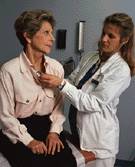
FRIDAY, Jan. 28 (HealthDay News) — “Getting back to basics” has become a mantra for those who think people have become too reliant on technology, and a growing number of medical experts would agree with the sentiment.
They’re concerned that doctors are neglecting the value of talking with patients and performing a hands-on physical examination in favor of newfangled tests and scans.
“I personally believe that 90 percent of the information you need to diagnose an illness can be obtained through a patient history and a physical examination,” said Dr. Marguerite R. Duane, a family physician with Columbia Road Health Services in Washington, D.C. “The value of testing is to confirm a suspected underlying abnormality and to monitor people with chronic illness.”
The pressure to rely on tests and imaging scans comes from several different sources, Duane said.
Doctors tend to lean on testing because it’s quick and easy, she said. To stay financially afloat, physicians often are forced to schedule just 15 minutes with each patient, she said — too little time to be able to perform a thorough examination.
“It’s much faster and easier to write an order for a blood test or a chest X-ray,” she said.
Doctors also face pressure from patients, who often insist on having tests run to verify the physician’s diagnosis. “There becomes an expectation that I need a test or image to know what’s wrong with me,” Duane said. “It takes so much time to explain why a patient doesn’t need a test [that] a doctor will just sign off on it.”
However, testing performed in lieu of careful examination can have serious downsides.
Dr. Glen Stream, president-elect of the American Academy of Family Physicians and a family doctor in Spokane, Wash., said that such tests can actually do harm to a patient, particularly invasive procedures such as heart catheterization or colonoscopy. Even CT scans subject the body to harmful radiation.
It’s also possible that a test or image alone won’t reveal what’s wrong with you, said Dr. Nesli Basgoz, a physician at Massachusetts General Hospital.
“Imaging can’t tell you how the patient is doing, the way talking to them and seeing them can,” she said. “And if you don’t know where to look, you might go looking in the wrong place. You might order a CT scan of the brain when the problem is in a peripheral nerve. You might image the completely wrong part of the body.”
Unnecessary testing also is expensive, contributing to the upward climb of health-care costs. For example, routine blood testing and urinalysis alone costs the U.S. health-care system about $80 million every year, Duane wrote in an editorial in American Family Physician.
What to do? Medical experts are grappling with ways to combat overreliance on scans and tests.
Part of the answer may lie in teaching the newest generation of doctors the importance of taking a thorough patient history and performing a detailed physical examination.
“You need to start in the med schools by focusing on physical diagnosis skills,” Duane said.
Stronger relationships between a person and their physician also can help, Stream said, by giving doctors more knowledge of the patient before they even walk through the door.
“I get to know them over time,” he said. “The physician knows more about the patient, and the patient develops a very important measure of trust in their physician. I know their history. I know what they do for work. And that helps me diagnose without having to resort to a test.”
Reestablishing the value of the physical examination could pay off huge benefits in the long run for the doctor, the patient and the entire health-care industry, Basgoz said.
“There’s no question in my mind that people who are alert and observant do make diagnoses that can’t be performed using a test,” she said. “That’s a really great thing, to use your brains and your hands to figure out what’s wrong with a person.
More information
The U.S. Centers for Disease Control and Prevention has more about the importance of regular check-ups.

